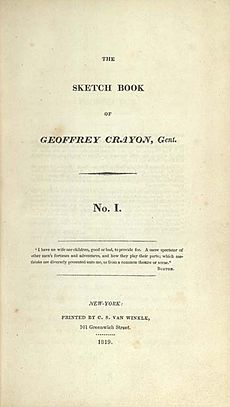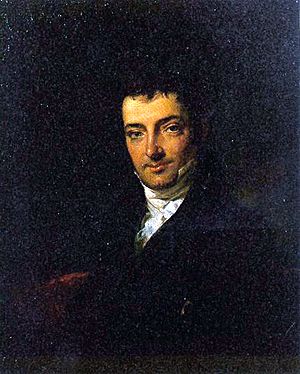Washington Irving facts for kids
Quick facts for kids
Washington Irving
|
|
|---|---|
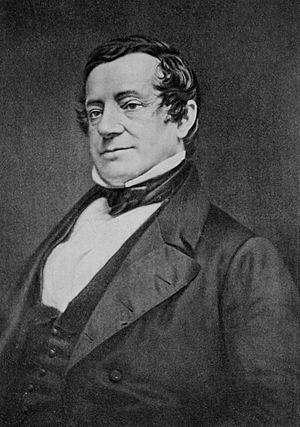
|
|
| Born | April 3, 1783 New York City, New York, U.S. |
| Died | November 28, 1859 (aged 76) Sunnyside, Tarrytown, New York, U.S. |
| Resting place | Sleepy Hollow Cemetery, New York |
| Pen name | Geoffrey Crayon, Diedrich Knickerbocker |
| Occupation |
|
| Language | English |
| Literary movement | Romanticism |
| Relatives | William Irving (brother) Peter Irving (brother) |
| Signature | |
| United States Minister to Spain | |
| In office 1842–1846 |
|
| President | John Tyler James K. Polk |
| Preceded by | Aaron Vail |
| Succeeded by | Romulus Mitchell Saunders |
Washington Irving (born April 3, 1783 – died November 28, 1859) was an American writer. He lived in the early 1800s. He wrote short stories, essays, and biographies. He also worked as a historian and a diplomat.
Irving is most famous for his short stories. These include "Rip Van Winkle" (1819) and "The Legend of Sleepy Hollow" (1820). Both stories are in his book The Sketch Book of Geoffrey Crayon, Gent.. He also wrote biographies of famous people. These include Oliver Goldsmith, Muhammad, and George Washington. He wrote histories about 15th-century Spain. These books covered topics like the Alhambra palace and Christopher Columbus. Irving even served as the American ambassador to Spain in the 1840s.
He was born and grew up in Manhattan. His family worked in business. Irving first started writing in 1802. He wrote letters to a newspaper called the Morning Chronicle. He used the pen name Jonathan Oldstyle. In 1815, he moved to England for his family's business. There, he became very famous. This happened after he published The Sketch Book of Geoffrey Crayon, Gent.. He kept writing and publishing books his whole life. He finished a five-book biography of George Washington. This was just eight months before he died at age 76.
Irving was one of the first American writers. He became well-known in Europe. He also encouraged other American authors. These included Nathaniel Hawthorne and Edgar Allan Poe. British writers like Charles Dickens also admired him. Irving believed writing should be a real job. He wanted stronger laws to protect writers from having their work copied.
Contents
Discovering Washington Irving's Life
His Early Years
Washington Irving's parents were William Irving Sr. and Sarah Saunders. His father was from Scotland. His mother was from England. They got married in 1761. William was in the British Navy. They had eleven children. Eight of them lived to be adults.
The Irving family lived in Manhattan. They were part of the city's business class. Washington was born on April 3, 1783. This was the same week New York City learned the American Revolution had ended. Irving's mother named him after George Washington. Irving met his namesake when he was six years old. George Washington was living in New York as president. The president blessed young Irving. Irving kept a painting of this meeting in his home.
The Irvings lived on William Street. Washington's brothers became successful merchants. They supported his dream of becoming a writer. They often helped him with money.
Irving was not a very interested student. He liked adventure stories and plays more. By age 14, he often snuck out of class. He would go to the theater. In 1798, yellow fever spread in Manhattan. His family sent him to stay with a friend. This friend was James Kirke Paulding in Tarrytown, New York. In Tarrytown, he learned about Sleepy Hollow, New York. He heard its Dutch customs and ghost stories. He took other trips up the Hudson River as a teenager. He visited Johnstown, New York. He passed through the Catskill Mountains. This area later became the setting for "Rip Van Winkle". Irving wrote that the Catskill Mountains had a "witching effect" on his imagination.
Irving started writing letters to the New York Morning Chronicle in 1802. He was 19. He wrote about the city's social life and theater. He used the pen name Jonathan Oldstyle. These letters made him a bit famous. Aaron Burr was impressed by his writing.
His brothers paid for him to travel in Europe. This was from 1804 to 1806. They were worried about his health. Irving didn't visit all the usual tourist spots. He focused on improving his social skills. He wrote, "I endeavor to take things as they come with cheerfulness." In Rome in 1805, he met painter Washington Allston. He almost became a painter himself. But he decided his path was different.
His First Big Writings
Irving returned from Europe to study law. He worked with Judge Josiah Ogden Hoffman in New York City. He admitted he wasn't a good student. He barely passed his law exam in 1806. He joined a group of young writers. He called them "The Lads of Kilkenny." In 1807, he started a magazine called Salmagundi. He worked with his brother William and friend James Kirke Paulding. He wrote under names like William Wizard. Irving made fun of New York culture and politics. The magazine was a success. It made Irving more known. In 1807, he gave New York City the nickname "Gotham." This old English word means "Goat's Town."
Irving finished A History of New-York in 1809. He was sad because his fiancée, Matilda Hoffman, had died. She was 17. This was his first major book. It made fun of local history and politics. Before the book came out, Irving played a trick. He put ads in New York newspapers. They asked for information about Diedrich Knickerbocker. This was a grumpy Dutch historian who had supposedly gone missing. The ads said if Knickerbocker didn't pay his hotel bill, his manuscript would be published.
People followed the story of Knickerbocker. Some city officials even offered a reward for him. Irving then published A History of New York on December 6, 1809. He used the Knickerbocker name. It was an instant success. Irving said it gave him "celebrity." The name Diedrich Knickerbocker became a nickname for New Yorkers. The New York Knicks basketball team even adopted it.
After A History of New York, Irving looked for a job. He became an editor for Analectic Magazine. He wrote about naval heroes. He also helped publish Francis Scott Key's poem "Defense of Fort McHenry". This poem became "The Star-Spangled Banner". Irving didn't like the War of 1812 at first. But when the British attacked Washington, D.C., he joined the military. He worked for the governor of New York. He didn't see much fighting. The war was bad for many American businesses. Irving's family business suffered. In 1815, he went to England to try and save it. He stayed in Europe for 17 years.
Life in Europe
The Sketch Book and Fame
Irving spent two years trying to save his family's business. But it went bankrupt. He had no job. So, he kept writing in 1817 and 1818. In 1817, he visited Walter Scott. They became lifelong friends.
Irving wrote "Rip Van Winkle" in one night. He was staying with his sister in Birmingham, England. This place also inspired other stories. In 1818, his brother William offered him a job. It was as chief clerk to the U.S. Navy. Irving turned it down. He wanted to be a writer in England.
In 1819, Irving sent some stories to his brother in New York. He asked him to publish them as The Sketch Book of Geoffrey Crayon, Gent.. The first part, with "Rip Van Winkle," was a huge hit. The rest of the book was also very popular. It came out in parts from 1819 to 1820. "The Legend of Sleepy Hollow" was in the sixth part.
Writers like Irving had a problem with "bootleggers." These were people who copied and sold books without permission. There were no international copyright laws then. To stop this in Britain, Irving paid to publish his book there.
He asked Walter Scott for help finding a good publisher. Scott sent him to John Murray in London. Murray agreed to publish The Sketch Book. From then on, Irving published his books in both the U.S. and Britain. This protected his copyright. Murray was his main English publisher.
Irving became very famous. For two years, he was popular in Paris and Britain. People saw him as a unique American writer. He wrote English very well.
More Stories: Bracebridge Hall and Tales of a Traveller
Irving and his publisher, John Murray, wanted another success. Irving traveled in Europe in 1821. He looked for new ideas. He read many Dutch and German folk tales. He had writer's block. He was also sad because his brother William died. He worked slowly. He finally gave his book to Murray in March 1822. The book was called Bracebridge Hall, or The Humorists, A Medley. It was published in June 1822.
Bracebridge was like The Sketch Book. Irving, as Crayon, told over 50 short stories and essays. Some critics thought it was not as good as The Sketch Book. But readers and critics liked it. One critic wrote, "We have received so much pleasure from this book." Irving was happy with its success. It made his reputation stronger in Europe.
Still struggling to write, Irving went to Germany. He stayed in Dresden in 1822. He met the royal family. He also met Amelia Foster and her five children. Irving liked Amelia's 18-year-old daughter, Emily. He wanted to marry her. But Emily said no in 1823.
He went back to Paris. He worked with playwright John Howard Payne. They translated French plays for the English stage. They didn't have much success. He also learned that novelist Mary Shelley was interested in him. But Irving didn't pursue a relationship.
In August 1824, Irving published Tales of a Traveller. This collection included "The Devil and Tom Walker". He used his Geoffrey Crayon name. Irving told his sister, "I think there are in it some of the best things I have ever written." But critics didn't like Traveller. They said Irving was "overrated." Irving was hurt by this. He went back to Paris. He worried about money and tried to think of new projects.
His Spanish Books
In Paris, Irving got a letter in 1826. It was from Alexander Hill Everett. Everett was the American Minister to Spain. He asked Irving to join him in Madrid. He said many old writings about the Spanish conquest were available. Irving went to Madrid. He eagerly searched Spanish archives for interesting stories.
Irving had access to a huge library of Spanish history books. He started working on several books at once. The first was A History of the Life and Voyages of Christopher Columbus. It was published in January 1828. This book was popular in the U.S. and Europe. It had 175 editions published. This was also the first book Irving published under his own name. He was invited to stay at the palace of the Duke of Gor. He could use the Duke's library of old manuscripts. Chronicle of the Conquest of Granada came out a year later. Then came Voyages and Discoveries of the Companions of Columbus in 1831.
Irving's books about Columbus mix history and fiction. This is called romantic history. He did a lot of research in Spanish archives. But he also added imaginative parts to make the story better. One of his books is the source of a popular myth. It says that people in the Middle Ages thought the Earth was flat. The book claims Columbus proved it was round.
In 1829, Irving was chosen for the American Philosophical Society. That same year, he moved into the old Alhambra palace in Granada. He wanted to stay there and write about the place. But he was soon told he was appointed Secretary to the American Legation in London. He didn't want to disappoint his friends and family. So, Irving left Spain for England in July 1829.
Working as a Diplomat in London
Irving arrived in London. He joined the staff of American Minister Louis McLane. McLane gave Irving the job of aide-de-camp. For the next year, they worked on a trade agreement. It was between the U.S. and the British West Indies. They made a deal in August 1830. That same year, Irving received a medal. It was from the Royal Society of Literature. In 1831, he got an honorary doctorate from Oxford.
McLane was called back to the U.S. in 1831. He became Secretary of Treasury. Irving stayed on as the legation's chargé d'affaires. He waited for Martin Van Buren to arrive. Van Buren was President Andrew Jackson's choice for British Minister. Once Van Buren was in place, Irving quit his job. He wanted to focus on writing. He finished Tales of the Alhambra. It was published in both the U.S. and England in 1832.
Irving was still in London when Van Buren learned something. The U.S. Senate had refused to approve him as Minister. Irving comforted Van Buren. He said the Senate's move would backfire. Irving predicted it might even help Van Buren become president.
Back in the United States
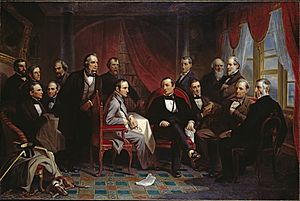
Irving returned to New York on May 21, 1832. He had been away for 17 years. That September, he went on a trip. He joined Commissioner on Indian Affairs Henry Leavitt Ellsworth. They traveled deep into Indian Territory (now Oklahoma). After his western tour, Irving visited Washington, D.C. and Baltimore. He met politician and novelist John P. Kennedy.
Irving had made some bad investments. He needed money. So, he started writing again. He wrote A Tour on the Prairies. It was about his travels on the frontier. The book was very popular. It was also the first book Irving wrote and published in the U.S. since 1809. In 1834, fur trader John Jacob Astor asked him to write a history. It was about Astor's fur trading colony in Astoria, Oregon. Irving quickly wrote Astoria. It came out in 1836. In 1835, Irving and Astor helped start the Saint Nicholas Society in the City of New York.
Irving stayed at Astor's home for a while. There, he met explorer Benjamin Bonneville. He was interested in Bonneville's maps and stories. They met again in Washington, D.C. Bonneville sold his maps and notes to Irving for $1,000. Irving used these for his 1837 book The Adventures of Captain Bonneville. These three books were Irving's "western" series. He wrote them partly because some critics said he was too European. Critics like James Fenimore Cooper felt he had forgotten his American roots. Irving's western books were well-liked in the U.S. But British critics accused him of just "book-making."
In 1835, Irving bought a "neglected cottage" in Tarrytown, New York. It was on the river. He named it Sunnyside in 1841. It needed constant repairs for 20 years. The costs kept going up. So, he agreed to write for The Knickerbocker magazine in 1839. He wrote new essays and stories. He used his Knickerbocker and Crayon names. Young writers often asked him for advice. This included Edgar Allan Poe.
In 1841, Irving was elected to the National Academy of Design. He also became friends with Charles Dickens. He hosted Dickens and his wife at Sunnyside in 1842.
Ambassador to Spain
President John Tyler chose Irving to be the Minister to Spain in 1842. Irving wrote that it would be hard to leave Sunnyside. But he hoped the job would help him write more. Spain was in political chaos during his time there. Different groups were fighting for control. They wanted to control the 12-year-old Queen Isabella II. Irving stayed on good terms with the generals and politicians. Spain's control changed hands often. Irving's reports on the civil war showed his romantic view of the queen. He saw her as a knight's protector. He wrote with a bias against republics. The politics and wars were tiring. Irving missed home and had a skin condition.
The political situation in Spain became more stable. Irving kept watching the new government. His job also involved trade with Cuba. He followed debates about the slave trade. He also helped negotiate the Oregon border dispute. This was a disagreement between the U.S. and Britain.
His Final Years and Death
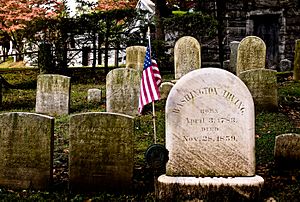
Irving came back from Spain in September 1846. He lived at Sunnyside. He started working on a "Revised Edition" of his books. This was for publisher George Palmer Putnam. He made a deal that gave him 12 percent of the sales. This was a very good deal for a writer then. As he revised his old books, he kept writing new ones. He published biographies of Oliver Goldsmith (1849) and Muhammad (1850). In 1855, he published Wolfert's Roost. This was a collection of stories and essays. He also started a biography of George Washington. He thought it would be his best work. Five books of the biography came out between 1855 and 1859.
Irving often traveled to Mount Vernon for research. He became friends with Presidents Millard Fillmore and Franklin Pierce. In 1855, he was elected to the American Academy of Arts and Sciences. He was also named an executor of John Jacob Astor's will in 1848. He became the first chairman of the Astor Library. This library later became part of the New York Public Library.
Irving kept socializing and writing letters into his seventies. His fame grew. Senator William C. Preston wrote to him, "I don't believe that any man, in any country, has ever had a more affectionate admiration for him than that given to you in America." By 1859, author Oliver Wendell Holmes Sr. said Sunnyside was "next to Mount Vernon, the best known and most cherished of all the dwellings in our land."
Irving died of a heart attack on November 28, 1859. He was 76 years old. This was just eight months after finishing his Washington biography. Legend says his last words were: "Well, I must arrange my pillows for another night. When will this end?" He was buried in Sleepy Hollow cemetery on December 1, 1859. Henry Wadsworth Longfellow wrote a poem about Irving's grave in 1876.
How sweet a life was his; how sweet a death!
Living, to wing with mirth the weary hours,
Or with romantic tales the heart to cheer;
Dying, to leave a memory like the breath
Of summers full of sunshine and of showers,
A grief and gladness in the atmosphere.
Washington Irving's Legacy
His Place in Literature
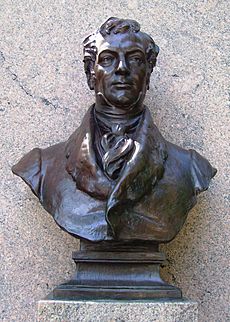
Irving is often called the first American Man of Letters. This means he was the first American to earn a living only by writing. Henry Wadsworth Longfellow said Irving helped American literature. He said Irving was the first to give America an "honourable name and position in the History of Letters."
Irving made the American short story popular. He was the first American writer to set his stories in the U.S. He used ideas from German or Dutch folklore. He is also known for writing in everyday language. His stories were meant to entertain, not just teach lessons. He also encouraged many new writers. George William Curtis said Irving always gave "the kindest words of sympathy" to young writers.
However, Edgar Allan Poe thought Irving was overrated. Poe said Irving was important as a pioneer. But he felt Irving's writing itself was often too simple. A critic for the New-York Mirror agreed. Some critics said Irving wrote for British tastes, not American.
Other critics liked his style more. William Makepeace Thackeray called Irving the "ambassador whom the New World of Letters sent to the Old." This idea was popular for many years. Critic H.R. Hawless wrote in 1881, "He is the first of the American humorists... yet belonging to the New World, there is a quaint Old World flavor about him." Early critics often saw Irving the man and Irving the writer as one. Later critics sometimes said his writing had style but no deep meaning.
As a historian, Irving's reputation changed over time. Later historians didn't always value his work. They saw his histories as more like stories. But recently, some of Irving's histories and biographies have been praised again. Scholars now respect them for being reliable and well-written. His books on Christopher Columbus, Astoria, and George Washington are now seen as important.
His Impact on American Culture
Irving made the nickname "Gotham" popular for New York City. He also created the phrase "the almighty dollar." The last name of his fictional historian, Diedrich Knickerbocker, is linked to New York. The New York Knicks basketball team uses it.
One of Irving's biggest impacts is on how Americans celebrate Christmas. In 1812, he added a dream scene to A History of New York. In it, St. Nicholas flies over rooftops in a wagon. Others later added to this idea, creating Santa Claus. In his five Christmas stories in The Sketch Book, Irving described old English Christmas customs. He saw these in England. His book helped bring back and change Christmas traditions in the U.S.
Irving also introduced a wrong idea. He wrote in his Columbus biography that Europeans thought the world was flat. This flat-Earth myth has been taught in schools for many generations. American painter John Quidor based many paintings on Irving's stories. These include Ichabod Crane Flying from the Headless Horseman (1828).
Memorials and Honors
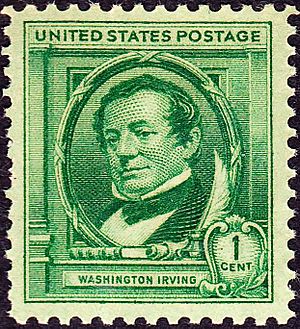
The village of Dearman, New York, changed its name to "Irvington" in 1854. This was to honor Washington Irving. He lived nearby at Sunnyside, which is now a museum. The train station also changed its name to "Irvington." The village officially became Irvington in 1872.
The town of Knickerbocker, Texas, was founded by two of Irving's nephews. They named it after his pen name. The city of Irving, Texas, is also named for Washington Irving.
Irvington, New Jersey is named after him too. It became a town in 1874.
Irving Street in San Francisco is named after him.
The Irving Park neighborhood in Chicago is also named for him.
Gibbons Memorial Park in Honesdale, Pennsylvania, is on Irving Cliff. The cliff was named after him.
The Irvington neighborhood in Indianapolis is another community named after him.
Irving College (1838-1890) in Irving College, Tennessee, was named for Irving.
Washington Irving's Works
| Title | Publication date | Written As | Genre |
|---|---|---|---|
| Letters of Jonathan Oldstyle | 1802 | Jonathan Oldstyle | Observational Letters |
| Salmagundi | 1807–1808 | Launcelot Langstaff, Will Wizard | Periodical |
| A History of New York | 1809 | Diedrich Knickerbocker | Satire |
| The Sketch Book of Geoffrey Crayon, Gent. | 1819–1820 | Geoffrey Crayon | Short stories/Essays |
| Bracebridge Hall | 1822 | Geoffrey Crayon | Short stories/Essays |
| Tales of a Traveller | 1824 | Geoffrey Crayon | Short stories/Essays |
| A History of the Life and Voyages of Christopher Columbus | 1828 | Washington Irving | Biography |
| Chronicle of the Conquest of Granada | 1829 | Fray Antonio Agapida | Romantic history |
| Voyages and Discoveries of the Companions of Columbus |
1831 | Washington Irving | Biography/History |
| Tales of the Alhambra | 1832 | "The Author of the Sketch Book" | Short stories/Travel |
| The Crayon Miscellany | 1835 | Geoffrey Crayon | Short stories |
| Astoria | 1836 | Washington Irving | History |
| The Adventures of Captain Bonneville | 1837 | Washington Irving | Biography/Romantic History |
| The Life of Oliver Goldsmith | 1840 (revised 1849) |
Washington Irving | Biography |
| Biography and Poetical Remains of the Late Margaret Miller Davidson |
1841 | Washington Irving | Biography |
| Mahomet and His Successors | 1850 | Washington Irving | Biography |
| Wolfert's Roost | 1855 | Geoffrey Crayon Diedrich Knickerbocker Washington Irving |
Short stories/Essays |
| The Life of George Washington (5 volumes) | 1855–1859 | Washington Irving | Biography |
See also
 In Spanish: Washington Irving para niños
In Spanish: Washington Irving para niños






